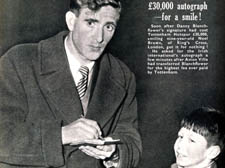|
|
 |
| |

Nine-year old King’s Cross boy Noel brown gets Danny Blanchflower’s autograph. From the issue of February 1955. Right an advert for Craven ‘A’ cigarettes. Bottom: An advert for Jimmy Hill’s ‘Kossak’ hat. On page 1: The cover of the first edition from September 1951. |
They’re football crazy
From Ron Atkinson’s window-cleaning business to the Jimmy Hill ‘Kossak hat’, Football Monthly turned the beautiful game into a must-read, writes Catherine Etoe
PIG-breeding footballers, £5 fines for hugging team mates, cigarette-promoting players... this doesn’t sound like the beautiful game I know.
But such quirks were part and parcel of football in the 1950s when a former Arsenal striker put his name to the sport’s first glossy magazine, Charles Buchan’s Football Monthly.
With its coloured images of smiling players, grumpy opinion pieces and adverts promoting everything from Jimmy Hill kossak (sic) hats to courses to make your ‘Muscles Like Granite’, Football Monthly brought soccer to the nation in a way the post-war newspapers could not match.
“Our object is to provide a publication which will be worthy of our national game and the grand sportsmen who play and watch it,” declared Buchan in 1951.
It was a target that Buchan struck as sweetly as the goals he had scored for Arsenal in the 1920s and Football Monthly quickly became the magazine “every schoolboy wanted to buy, every player wanted to be part of”.
Charlie died in 1960 with circulation hitting 125,000 but his spirit lived on and by 1969, it had hit around 240,000.
But the magazine didn’t just turn football into a good read, it imbued it with a respectability which had been missing in post-war Britain.
“It was a magazine which took football seriously and allowed middle-class readers and schoolboys to not be ashamed or think that football was beneath them,” says Simon Inglis, editor of new book, The Best of Charles Buchan’s Football Monthly. “It was fighting snobbery.” With a hardened team of Fleet Street hacks behind him, footballer turned journalist Buchan was the ideal character to lead the fight.
“Buchan was a bit of a maverick, outspoken and very much a man of Fleet Street,” adds Inglis, former chairman of Friends of West Hampstead Library. “He didn’t just sell his name for a franchise, he actually went into the office and reported on matches.”
As part of his research, Inglis, also a renowned architectural historian, spent the summer at his West Hampstead home reading all 240 issues which were produced under Buchan’s name.
His dedication paid off as he unearthed readers’ letters written by commentator John Motson as a teenager and opinion pieces such as Ronald Allen’s bid to have a cup of tea served to fans at half time.
Inglis says: “There was some good writing in it, it was an instant collectible and as an artefact, the pictures in it are beautiful. You don’t have to know anything about football to see those as artefacts of their time.”
Which is why this compilation is part of English Heritage’s ‘Played in Britain’ series which celebrates architectural and archaeological examples of sporting heritage ranging from billiard halls and ice rinks to balls.
Series editor Inglis says it is an area often overlooked by academics and conservationists.
He says: “People are very concerned about castles and medieval toll booths, but when it comes to Kentish Town baths and billiard halls, there has been very little support.
“So the Buchan compilation is a way of adding the visual heritage of sport to what we are doing and also bringing a wider audience to the series.”
The visuals in this ‘Best Of’, designed by Doug Cheeseman of When Saturday Comes, will attract younger readers just as they did when the magazine was at its height.
But for football fanatics, its stories and Inglis’s commentary make it more than a coffee table decoration.
Inglis says: “We chose the articles not just to get a spread of the clubs but to illustrate how football and society have changed.
“In the early years there is a lot of reference to the army and players who had done national service.”
Hairstyles, adverts and even language change as the book traverses the decades.
A running theme was making your way after football, with Ron Atkinson commended for having sorted himself a window cleaning business.
The compilation ends when Buchan’s name was dropped from the masthead in the 1970s amid diminishing circulation brought on by the arrival of the sexier Goal.
Football Monthly met its demise not long after, but Inglis, thanks to the co-operation of the magazine’s rights holders and backing of English Heritage, looks set to bring a new audience to a once firm favourite.
Inglis adds: “That world has gone so using the magazine as a way of evoking the period is a very efficient way of doing it.
“You can read any number of football books but you can’t beat the small ads at the back and the pictures and snippets to harken back to an era. I think Charlie did pretty well to last for 25 years.”
|
 |
 |
|
 |
|


